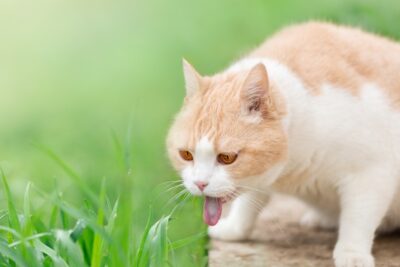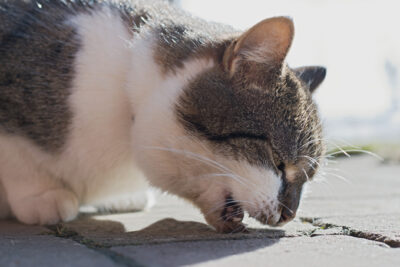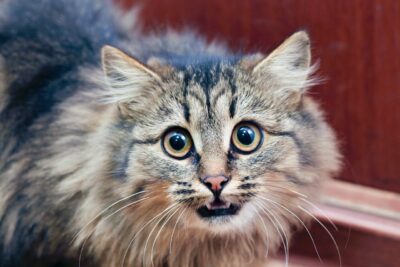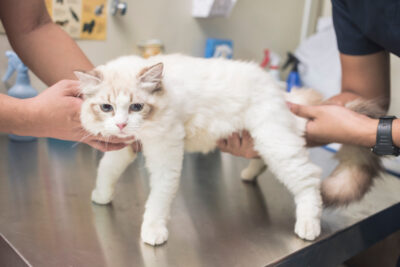All About Dandruff in Cats

Overview
- Yes, cats can experience dandruff, just like humans can.
- Dandruff occurs when a cat’s skin is either traumatized or off balance from the inside out.
- Dandruff in cats can signal an underlying health problem, so if your cat has excessive dandruff, she should be seen by a veterinarian.
- If your cat shows any symptoms such as weight loss or change in appetite, seek veterinary attention.
- For mild cases of dandruff in cats—where no other symptoms are present—there are some home treatments that can help.
Dandruff is a fairly common issue for our cats, and most of the time, it’s not considered a serious issue. However, there are many reasons why a cat may have dandruff, and it deserves some attention.
Dandruff can be uncomfortable and indicate something more serious or painful is occurring. Read below to understand the process behind dandruff, causes of dandruff on cats, and ways to treat it both at home and with the help of your veterinarian.
Can Cats Get Dandruff?
Yes, cats can experience dandruff, just like humans can. For both cats and humans, the skin cycle involves cells being made deep in the skin, becoming more and more superficial (or close to the surface) until the cells die, harden, and slough off in small flakes. In fact, skin has many many layers of dead skin cells waiting to be sloughed! It acts as a natural protective layer for everything else inside the body.
Dandruff is when the cells of the skin die, harden, and slough off more rapidly than normal. This can be caused by something as simple as dry air or as serious as skin cancer.
Most cats do not show obvious symptoms related to dandruff. But in some cases, there are signs, usually related to itchiness.
What Causes Dandruff in Cats?

Dandruff occurs when a cat’s skin is either traumatized or off balance from the inside out. Oftentimes, something on the skin is causing inflammation such as parasites or infection. Other times, something internally causes an imbalance in the nutrients to the skin, the oils in the skin, and the skin’s normal cycle. Below are more common causes of dandruff, as well as some uncommon and even rare causes.
Common causes of dandruff in cats:
- Obesity
- Poor grooming
- Parasites (i.e. fleas, mites, or feline lice)
- Ringworm
- Allergies – either topical (reaction to something that touched the skin) or generalized (typically to the environment, food or fleas)
- Infection (i.e. yeast or bacteria)
Less common causes of dandruff in cats:
- Poor nutrition
- Poor environmental conditions (very dry and/or not clean)
- Endocrine disorders (i.e. hyperthyroidism)
- Cancers such as skin lymphoma (rare)
- Keratinization disorder, when the outer layer of the skin sloughs abnormally (very rare)
Poor grooming is a generic but very common cause of dandruff in cats. Anything that could decrease a cat’s grooming is serious and requires attention, as grooming is a natural and stress-reducing activity for cats.
Senior cats can experience dandruff due to poor grooming for a couple reasons. Arthritis in the back can make it uncomfortable for cats to turn around and groom their backs. Senior cats are also less active and more apt to become obese. Obese cats often cannot physically reach their entire body to groom.
Symptoms of Dandruff in Cats

Dandruff on cats looks like it does on humans. It appears as very small, white flakes coming from the root of the fur toward the tip. In excessive cases, much bigger pieces of dandruff may be visible.
It is typical for cats to have some dandruff—it is a natural process, after all. However excessive dandruff will have the following characteristics:
- Dandruff is clearly visible across the whole body
- Dandruff is clearly visible from a couple feet away
- Amount of dandruff increases
- Size of the dandruff flakes gets larger
- Your cat licks the air or a part of her (like her front legs) when you pet or scratch a certain area
Symptoms that can occur along with cat dandruff include:
- Fur loss
- Unkempt (messy, greasy) fur coat
- Very small crusts on the skin (stuck to the skin, not flaking like dandruff)
- Skin redness
- Frequent grooming
- Clumps of fur around the house
- Odor to the fur/skin
- Weight gain/obesity
- Weight loss
Occasionally mites known as Cheyletiella are mistaken for flakes of dandruff. The nickname for the mite is “walking dandruff.” If you watch closely, you can see the mites moving with the naked eye. Luckily these are not super common and are usually found on cats living in crowded conditions with other animals, such as breeders, groomers, or animal shelters.
Diagnosing Dandruff in Cats

Dandruff is diagnosed based on a veterinarian’s exam. If there are any other symptoms from your cat or the dandruff seems excessive, your cat needs to see a veterinarian.
A complete physical examination is important to look for changes in the skin other than the dandruff, as well as any other abnormalities. Your veterinarian will also weigh your cat and evaluate if she needs to lose or gain weight.
Testing is very important in determining the cause of dandruff in cats. Typically, your veterinarian will perform a couple specific skin tests. These tests include:
Skin scrape: This test looks for the presence of mites.
Ringworm culture (DTM): This skin test looks for ringworm, a fungal infection of the fur.
Cytology: Veterinarians will look closely at dandruff flakes to ensure they are not actually mites. Cytology also looks for bacteria or yeast from the skin. Technicians may use clear tape to get their sample.
Trichogram: During this test a cat’s fur is plucked, looking for mites or ringworm.
If these skin tests do not reveal anything, and your veterinarian notes other concerns after examining your cat, other tests may be recommended.
Bloodwork is a common way to look for underlying health issues. Biopsy involves anesthetizing your cat briefly to take a very small piece of skin and send it to a specialist to examine.
Allergies are often related to cat dandruff. While there are blood tests that can help determine the cause of allergies, definitive testing usually requires a skin specialist (a dermatologist). Most of the time, allergies are diagnosed through trial and error. For example, if your cat is treated for fleas and the symptoms and dandruff go away, your cat is likely flea allergic.
How to Treat Dandruff in Cats

Dandruff in cats can signal an underlying health problem, so if your cat has excessive dandruff, she should be seen by a veterinarian. For mild cases of dandruff in cats—where no other symptoms are present—there are some home treatments that can help.
Home Remedies for Dandruff in Cats
If your cat is not showing any other symptoms, trying home remedies for dandruff may be worthwhile.
Possible home remedies may include:
- Feeding a high-quality commercial diet. Ask your veterinarian for recommendations.
- Increase the humidity in your house in cold-weather months.
- Try omega-3 fatty acid supplements for cats, which are available over the counter.
- If your cat is obese, measure the amount your cat is eating and very slowly decrease the total amount of food by 10 percent whenever your cat is the same weight for 2-3 weeks.
- Groom your cat regularly. Ask a grooming professional or your veterinarian to safely remove matting as soon as it forms.
If your cat’s dandruff worsens at any time, or if you notice appetite changes, behavioral changes, or skin problems like fur loss, you should bring your cat to the veterinarian right away.
Veterinary Treatments for Cat Dandruff

If you’re concerned about your cat’s dandruff, schedule an appointment to see your veterinarian. There are several vet-recommended products and prescription medications and shampoos that help get rid of feline dandruff.
Veterinary treatments for cat dandruff may include:
- Omega-3 fatty acids (free form fatty acids found in veterinary products, more potent than over-the-counter products)
- Flea/mite preventive medications
- Topical products containing fatty acids and oils (to hydrate the skin)
- Topical spray-on products that combat yeast or bacterial infections
- Shampoos meant to decrease shedding of skin (seborrheic or keratinolytic)
- Other medications by mouth such as antibiotics, antifungals, supplements
General Cost to Treat Dandruff in Cats
The cost of treating dandruff varies considerably depending on where you live as well as the underlying cause of the dandruff.
If your cat has a flea allergy or mites and requires a couple months of topical medication, along with a veterinary examination you may only spend $100-$200.
However, if your cat has a chronic condition such as allergies or a yeast infection treatment for dandruff and the underlying condition may be more costly. The examination, testing, and long-term medications can cost closer to $300-$500 at the beginning of treatment.
How to Prevent Cat Dandruff

Preventing dandruff in cats can be accomplished in some cases. Here are some tips for keeping your cat’s skin healthy:
- Feed a high-quality commercial diet.
- Avoid obesity by controlling the number of calories your cat eats.
- Use flea preventives monthly.
- Provide plenty of enrichment, or activity, to keep your cat stress free.
- Brush your cat daily if there are areas she cannot reach for grooming.
- Provide increased humidity in the winter or drier months.
If your cat shows any symptoms such as weight loss or change in appetite, seek veterinary attention right away.
Related Conditions
- Obesity
- Fleas
- Cheyletiella (mites)
- Ringworm
- Allergies
- Yeast infection









